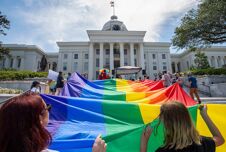It was a pleated American Apparel skirt – one of many casualties in Depop’s assault on my finances. I wouldn’t wear it outside my house until several years later, but it remains a wardrobe favorite. The purchase, the first item of visibly feminine clothing I ever bought, was made in a series of rash pandemic decisions emboldened by reality’s impermanence. I hadn’t left my home in months other than to secure rations at the local Food Lion and attached smoke shop. Call it Schroedinger’s Skirt.
In the summer of 2020, video saturation was high, and will to live was at an all-time low. One TikTok trend, in particular, caught my attention – Femboys. Even typing the words makes me cringe in 2023. Femboys are defined as “a slang term for a young, usually cisgender male who displays traditionally feminine characteristics. While the term can be used as an insult, some in the LGBTQ community use the term positively to name forms of gender expression.” Femboys can be of any sexual orientation and many straight participate in the trend.
Related:
The drag queen activist who ran for office 16 years before Harvey Milk
Jose Sarria originally wanted to be a teacher. But one arrest helped him go from drag queen to political legend.
Driven by popular TikTok trends like #femboyfriday and #femboyhooters, suddenly these androgynes, with their ill-fitted maid costumes and chipped nail polish, were the hot new thing. Internet culture journalists described femboys with doting warmth, whether as a wholesome trend or an inclusive community. Forums on Reddit, like r/femboy, erupted, now boasting over 300k users. Its NSFW counterpart, r/FemBoys, has over double that amount. Must be a glitch.
Never Miss a Beat
Subscribe to our newsletter to stay ahead of the latest LGBTQ+ political news and insights.

Frankly, I was inspired to explore my femininity out of spite. I spent my whole life performing second-rate masculinity only for straight men to waltz into the corners of gender expression that I had deemed off-limits. So, I bought the skirt – an omen to the gender turbulence I’ve experienced in the years since. This change represented a landmark in my personal history that would go on to profoundly affect how I saw myself and the world. Yet, media analysis consistently reduced femboys to a viral trend. A cutesy gimmick from a generation obsessed with being different. In truth, femboys are cultural artifacts of both the past and future.
Queer historian George Chauncey describes how 19th-century effeminate gay men were referred to as ‘fairies,’ a third gender that preceded the concept of homosexuality. Similar to femboys, fairies did not fit neatly into defined binaries of sexuality and gender. Fairies were replaced by homosexuals when 20th-century psychiatrists sought to name their devil through discrete categories. You are a man or woman. Straight or gay. Maybe bisexual, but probably lying. This system, what Chauncey describes as the making of the ‘gay world,’ would reign as hegemon until the past decade. Femboys are not isolated specimens but indictments of larger cultural cracks in the gender binary’s dam – and no one knows it better than straight men:

As modern gender and sexuality melt, labels like gynosexual emerge to make sense of the cognitive dissonance. Gynosexuality describes an attraction to femininity unbound by gender classifications. Similarly, Grindr profiles titled Str8ForFem specify that they’re only interested in cis women, trans women, crossdressers, femboys, and, sometimes, twinks – in that order. A straight man on Grindr is only oxymoronic in Chauncey’s modern gay world. Prior, men were regarded as ‘normal’ as long as they were masculine tops, regardless of the gender of their sexual partners. Only the fairies, with their tweezed eyebrows, powdered faces, and penetrated assholes, were othered.
Femboys represent something far greater than an algorithmic Gen-Z internet meme. They are canaries whistling at a frequency too high for heterosexual ears, exemplifying a collective societal reversion to the 19th-century cultural schema that predated Kinsey’s scale, when, as Chauncey writes, “gender status superseded sexuality as the basis of sexual classification.” What everyone saw as a brave show of a new generation’s willingness to gender-bend, a futuristic signal of progress, actually harkens back hundreds of years. Welcome to the (re)making of the queer world.
Editor’s note: This article originally named the 17th century, when it was actually referring to the 19th















